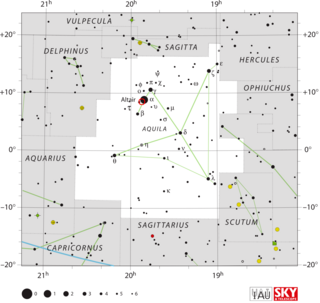
V500 Aquilae also known as Nova Aquilae 1943 was a nova which appeared in the constellation Aquila, very near the star Altair, in 1943. It was discovered by Cuno Hoffmeister on photographic plates taken at Sonneberg Observatory on 5 September 1943, when it had a photographic magnitude of 12. It reached its peak brightness sometime between 13 April 1943 when it was fainter than photographic magnitude 13.5, and 2 May 1943 when its photographic magnitude was 6.55.

DK Lacertae was a nova, which lit up in the constellation Lacerta in 1950. The nova was discovered by Charles Bertaud of the Paris Observatory on a photographic plate taken on 23 January 1950. At the time of its discovery, it had an apparent magnitude of 6.1. DK Lacertae reached peak magnitude 5.0, making it easily visible to the naked eye.
An Alpha2 Canum Venaticorum variable is a type of variable star. These stars are chemically peculiar main sequence stars of spectral class B8p to A7p. They have strong magnetic fields and strong silicon, strontium, or chromium spectral lines. Their brightness typically varies by 0.01 to 0.1 magnitudes over the course of 0.5 to 160 days.
Lambda Ursae Minoris is a star in the constellation Ursa Minor. It is an M-type red giant with an apparent magnitude of +6.38 and is approximately 880 light years from Earth.

A U Geminorum-type variable star, or dwarf nova is one of several types of cataclysmic variable star, consisting of a close binary star system in which one of the components is a white dwarf that accretes matter from its companion. Dwarf novae are dimmer and repeat more frequently than "classical" novae.
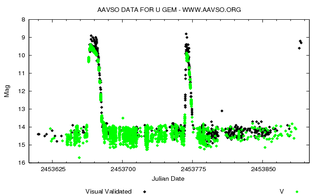
U Geminorum, in the constellation Gemini, is an archetypal example of a dwarf nova. The binary star system consists of a white dwarf closely orbiting a red dwarf. Every few months it undergoes an outburst that greatly increases its brightness. The dwarf nova class of variable stars are often referred to as U Geminorum variables after this star.

AG Draconis is a binary star system in the northern constellation of Draco. It consists of a giant star and a white dwarf that revolve around each other every 550 days.

V385 Andromedae is a variable star in the constellation Andromeda, about 360 parsecs (1,200 ly) away. It is a red giant over a hundred times larger than the sun. It has an apparent magnitude around 6.4, just about visible to the naked eye in ideal conditions.

RX Andromedae is a variable star in the constellation of Andromeda. Although it is classified as a dwarf nova of the Z Camelopardalis (UGZ) type, it has shown low-luminosity periods typical of VY Sculptoris stars. However, for most of the time it varies from an apparent visual magnitude of 15.1 at minimum brightness to a magnitude of 10.2 at maximum brightness, with a period of approximately 13 days.

Chi2 Orionis is a B-type supergiant star in the constellation of Orion. It has an apparent visual magnitude of 4.63 but being quite distant, and heavily extinguished it burns with the greatest absolute visual light magnitude among stars in Orion within the near reaches of the galaxy, 0.9 of a magnitude greater than Rigel. Since 1943, the spectrum of this star has served as one of the stable anchor points by which other stars are classified.
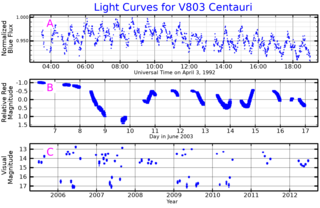
V803 Centauri is a cataclysmic binary consisting of a dwarf helium star losing mass to a white dwarf. It is an example of the AM Canum Venaticorum type of cataclysmic variable stars.

AW Canum Venaticorum is a variable star in the constellation Canes Venatici. It is visible to the naked eye with a nominal apparent visual magnitude of 4.76. The distance to this star, as measured from its annual parallax shift of 5.3 mas, is around 620 light years. It is moving closer with a heliocentric radial velocity of −44 km/s.

10 Persei is a blue supergiant star in the constellation Perseus. Its apparent magnitude is 6.26 although it is slightly variable.

BV Centauri is a cataclysmic variable binary star in the constellation Centaurus. It is a dwarf nova, and undergoes rapid increases in brightness that are recurrent with a mean period of 150 days. This period seems to have increased in the last few decades. During quiescence, its visual apparent magnitude is about 13, with variations of a few tenths of magnitude over an orbit due to differences in the star's visible surface area, brightening to a maximum magnitude of 10.7 during outbursts. From its luminosity, it is estimated that the system is about 500 parsecs (1,600 ly) away from Earth. A Gaia parallax of 2.81 mas has been measured, corresponding to about 360 pc.
SU Ursae Majoris, or SU UMa, is a close binary star in the northern circumpolar constellation of Ursa Major. It is a periodic cataclysmic variable that varies in magnitude from a peak of 10.8 down to a base of 14.96. The distance to this system, as determined from its annual parallax shift of 4.53 mas, is 719 light-years. It is moving further from the Earth with a heliocentric radial velocity of +27 km/s.
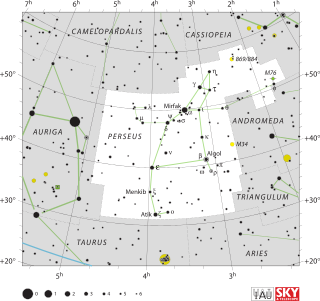
V392 Persei, also known as Nova Persei 2018, is a bright nova in the constellation Perseus discovered on April 29, 2018. It was previously known as a dwarf nova.
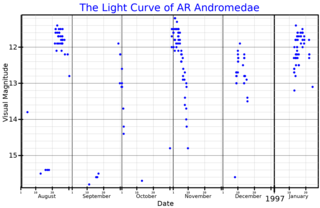
AR Andromedae is a dwarf nova of the SS Cygni type in the constellation Andromeda. Its typical apparent visual magnitude is 17.6, but increases up to 11.0 magnitude during outbursts. The outbursts occur approximately every 23 days.

DX Andromedae is a cataclysmic variable star in the constellation Andromeda. It has a typical apparent visual magnitude of 15.5 during the quiescent phase, but becomes brighter during outbursts recurring with a mean cycle length of 330 days, thus is classified as a dwarf nova of the SS Cygni type.

PX Andromedae is an eclipsing cataclysmic variable star in the constellation Andromeda. It has been classified as a SW Sextantis variable, and its apparent visual magnitude varies between 14.04 and 17.

V455 Andromedae is a dwarf nova in the constellation Andromeda. It has a typical apparent visual magnitude of 16.5, but reached a magnitude of 8.5 during the only observed outburst.

















